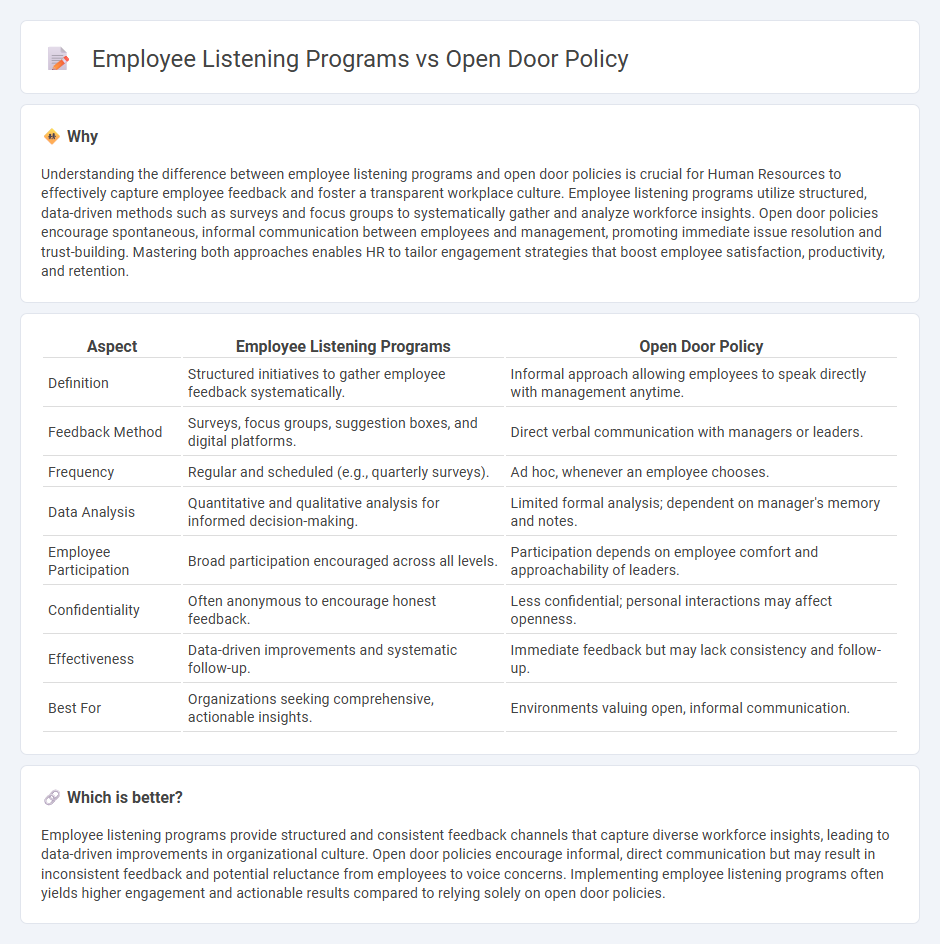
Employee listening programs utilize structured feedback tools such as surveys and focus groups to capture workforce insights systematically, enhancing engagement and driving informed decision-making. Open door policies encourage spontaneous, direct communication between employees and management, fostering transparency and a culture of trust but may lack consistent data collection. Explore the unique benefits of both approaches to optimize your organization's communication strategies.
Why it is important
Understanding the difference between employee listening programs and open door policies is crucial for Human Resources to effectively capture employee feedback and foster a transparent workplace culture. Employee listening programs utilize structured, data-driven methods such as surveys and focus groups to systematically gather and analyze workforce insights. Open door policies encourage spontaneous, informal communication between employees and management, promoting immediate issue resolution and trust-building. Mastering both approaches enables HR to tailor engagement strategies that boost employee satisfaction, productivity, and retention.
Comparison Table
| Aspect | Employee Listening Programs | Open Door Policy |
|---|---|---|
| Definition | Structured initiatives to gather employee feedback systematically. | Informal approach allowing employees to speak directly with management anytime. |
| Feedback Method | Surveys, focus groups, suggestion boxes, and digital platforms. | Direct verbal communication with managers or leaders. |
| Frequency | Regular and scheduled (e.g., quarterly surveys). | Ad hoc, whenever an employee chooses. |
| Data Analysis | Quantitative and qualitative analysis for informed decision-making. | Limited formal analysis; dependent on manager's memory and notes. |
| Employee Participation | Broad participation encouraged across all levels. | Participation depends on employee comfort and approachability of leaders. |
| Confidentiality | Often anonymous to encourage honest feedback. | Less confidential; personal interactions may affect openness. |
| Effectiveness | Data-driven improvements and systematic follow-up. | Immediate feedback but may lack consistency and follow-up. |
| Best For | Organizations seeking comprehensive, actionable insights. | Environments valuing open, informal communication. |
Which is better?
Employee listening programs provide structured and consistent feedback channels that capture diverse workforce insights, leading to data-driven improvements in organizational culture. Open door policies encourage informal, direct communication but may result in inconsistent feedback and potential reluctance from employees to voice concerns. Implementing employee listening programs often yields higher engagement and actionable results compared to relying solely on open door policies.
Connection
Employee listening programs and open door policies are interconnected strategies that enhance workplace communication and trust. Both approaches facilitate direct employee feedback, enabling management to address concerns promptly and foster a culture of transparency. Implementing these practices leads to increased employee engagement, higher job satisfaction, and improved organizational performance.
Key Terms
Accessibility
An open door policy ensures employees have direct access to managers, promoting transparency and quick conflict resolution, while employee listening programs use structured tools like surveys and feedback platforms to gather broad, systematic input. Accessibility in open door policies depends on managerial availability and approachability, whereas employee listening programs provide scalable and anonymous channels for all employees to voice concerns. Explore how combining both methods can enhance organizational communication and employee engagement.
Feedback Channels
Open door policies encourage spontaneous, direct communication between employees and management, fostering an environment where issues can be addressed immediately. Employee listening programs utilize structured feedback channels such as surveys, suggestion boxes, and digital platforms to gather comprehensive insights from the workforce. Explore how these feedback mechanisms enhance organizational transparency and employee engagement.
Trust
An open door policy fosters trust by encouraging transparent communication where employees feel comfortable sharing concerns directly with management, promoting a culture of openness and accessibility. Employee listening programs build trust through structured feedback mechanisms that demonstrate the organization's commitment to valuing employee input and driving meaningful change based on responses. Explore the differences in how these approaches impact workplace trust and engagement to determine the best fit for your company culture.
Source and External Links
Open door policy (business) - An open door policy in business encourages open communication and transparency between employees and management, fostering collaboration and mutual respect.
Open Door Policy in the Workplace - This policy empowers employees to communicate job-related issues with leaders, promoting employee morale and engagement.
Open door policy: definition and benefits - This policy enhances workplace communication, preventing divides between managers and employees by allowing open discussion of various topics.
 dowidth.com
dowidth.com